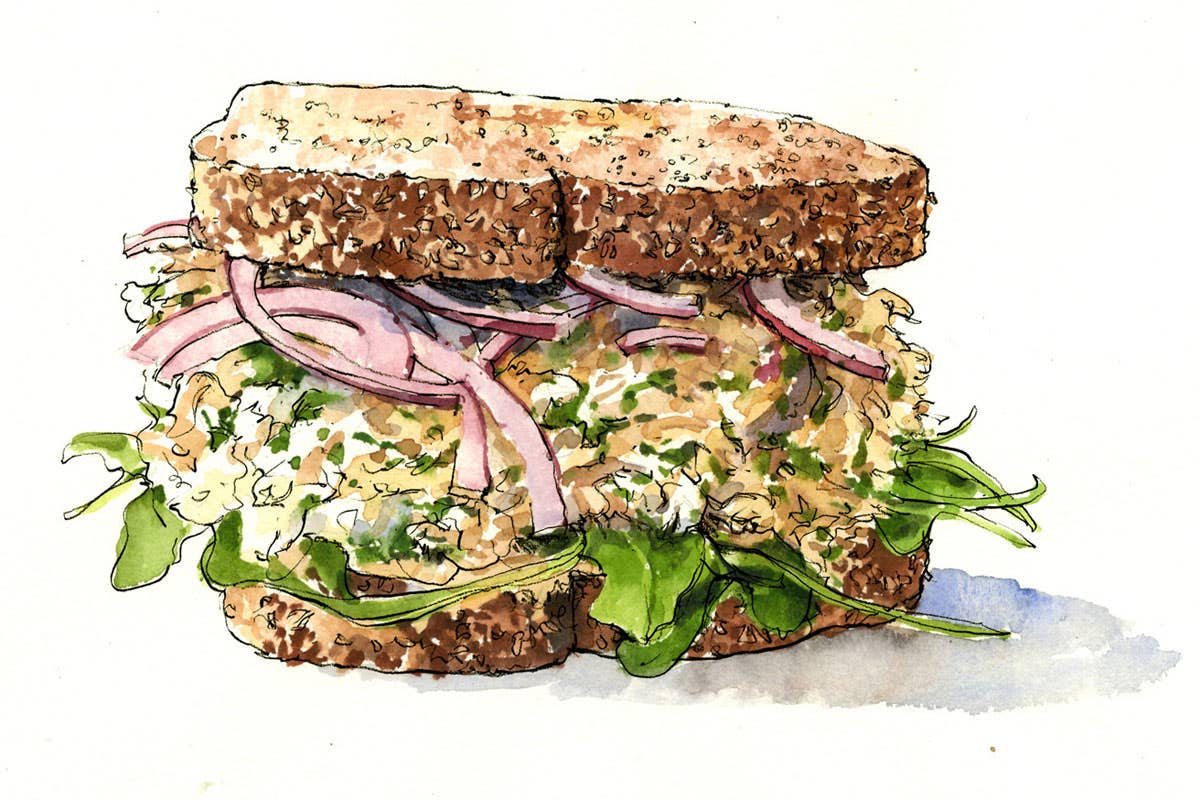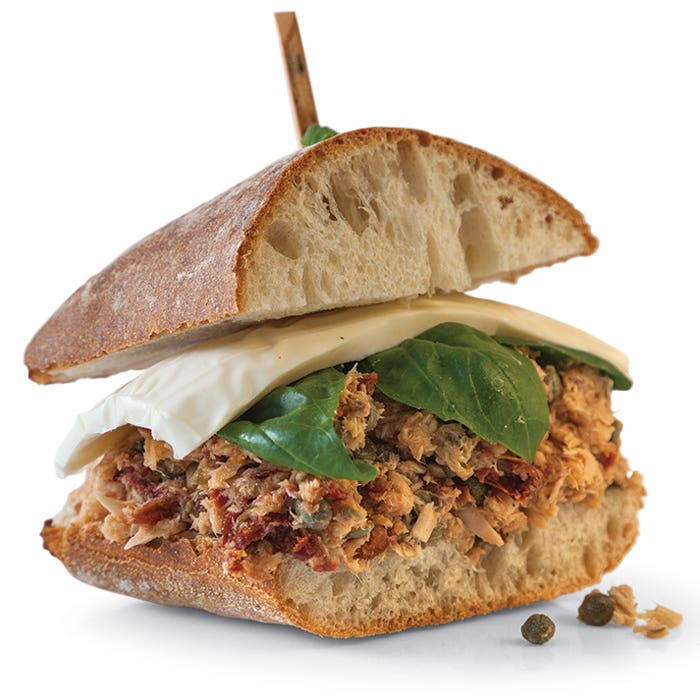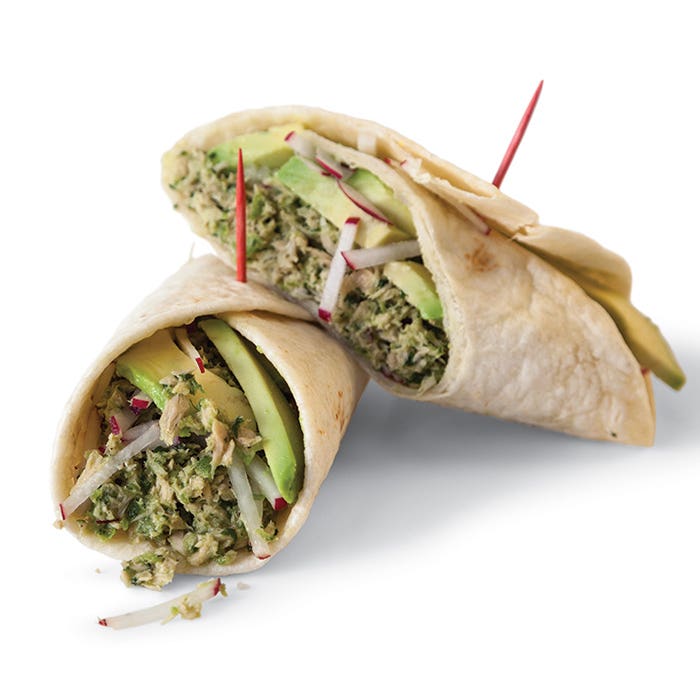
Everyman’s Fish
One writer recounts his lifelong love for the tuna sandwich, the unsung hero of the American lunch
Long gone from Washington, D.C., Sholl's Colonial Cafeteria in 1968 was the kind of place that reminded you of everything pleasant about America's humdrum side. Yet nothing about the United States was humdrum to me because I was a State Department brat who'd grown up abroad.
Now that we had moved home again (whatever “home” meant), I had to keep trying new foods if I wanted to eat at all. Sometime that summer, while my family was camped out at a temporary apartment near Dupont Circle on the taxpayers' dime, I ate my very first tuna-salad sandwich at Sholl's. It was a classic, meaning basic: mayo and canned tuna on white bread with a dab of iceberg lettuce. While most restaurants anywhere north of Sholl's in culinary pride would consider it unworthy of the dignity of being plated, no tuna sandwich I've eaten since has come close to its thunderous bestowal of citizenship.
Of course, 1968 was eventful in far more profound ways. That spring my father, a loyal Democrat, had muttered, “Oh, no” and wept as Lyndon Baines Johnson announced he wouldn't run for re-election. Robert F. Kennedy and Martin Luther King were both assassinated. August brought the Democratic convention, with Chicago cops and protesters swaying in disharmony like a carpet at war with its own patterns. This was my introduction to America.
Amid such unrest, that tuna sandwich represented tranquility. It didn't taste like some confusing assassination somewhere, though the tuna in question might disagree. It didn't taste like splinters from a billy club or life in a hotel. Saying it tasted like color TV is getting closer to the sensation. It was comforting, accessible. It tasted like democracy. One bite turned me American, launching a love affair with tuna sandwiches—and a quest to recover that magic moment—that continues to this day.
As introductions to democracy go, tuna had the right pedigree. In the 19th century, it was immigrant food. Most Americans considered tuna a trash fish. But then sport fishing was invented, as per Andrew Smith's American Tuna (University of California Press, 2012), and eventually the gentleman's struggle to tackle one of the ocean's most impressive predators popularized tuna and led to its exploitation as a cheap canned food for the masses.
Tuscan Tuna Sandwich
Mixed with capers and sun-dried tomatoes, tuna salad pairs well with classic Italian ingredients in this Tuscan-inspired sandwich served on ciabatta with mozzarella and basil.
The lowly tuna sandwich became a common sight in diners and Automats after the turn of the last century, when, amid the burgeoning American mania for convenience, we fell in love with new food-packaging technologies. Though the canneries of the early 20th century went the way of other American industries—offshore—the U.S. today consumes nearly a third of the world's canned tuna. Drained of its own oil to ensure its blandness and packed with water or vegetable oil, tinned tuna inculcated itself into our popular cuisine.
As I look back, my adult love affair with the tuna-salad sandwich falls neatly into three Proustian phases. Back in 1988, having broken up with the girlfriend I'd moved to Los Angeles with three years earlier, I was living near the Hollywood Freeway and coming as close to turning into a barfly as I ever will. Since they were within walking distance, I made the rounds almost nightly of the local dive bars: the Gaslight, the Firefly, the shabby, venerable Frolic Room.
Come closing time, the 7–11 on the way home was my final stop. One night I discovered they had added a new sandwich: the Tuna Laguna, a thing of glory encased in the convenience-store chain's crust-challenged idea of a baguette. In an added touch of elegance—and compared with most bachelor food, tuna salad does become one's operative definition of elegance—two puzzled-looking walnuts sat atop the filling, peering up at me like Dr. T.J. Eckleburg's eyes in The Great Gatsby.
Love was what I was looking for at the Gaslight, the Firefly, and the Frolic Room, but since I was not having luck at any of them, I fell in love with the Tuna Laguna instead. Soon I could almost taste those puzzled walnuts as I ordered one more beer while AC/DC's “Highway to Hell” blasted and pretty girls with trashy eyes vied with trashy girls with pretty eyes for the attentions of someone else. Soon I was not waiting until closing time. In short, the Tuna Laguna saved me from turning barfly.
Luckily for me, by the time it was taken off the menu, I was no longer single. At home, my new wife and I were learning to cook, and 7–11s were a dimming memory. The handiest place to get a bag lunch near the office of the L.A. alternative weekly she and I both worked for was a twee shop called What a Friend We Have in Cheeses. Their tuna sandwich was a beauty. Thick sourdough, sprouts, tomato, and the gooiest havarti topped a hefty heap of tuna. I put on ten pounds in two months. That's when I decided that I'd better work at home, but I felt no obligation to lose the ten pounds. I was married, and they were a very contented ten pounds.
Taco Truck Tuna Sandwich
The bright flavors of lime, cilantro, and jalapeño are puréed together and combined with canned tuna fish for a unique, taco-inspired wrap.
Flash forward to the present. That marriage is over. But in my capacity as GQ's movie reviewer, my attendance at the Toronto Film Festival is ongoing. Each year I stay at the Metropolitan Hotel, home of Lai Wah Heen, one of the best dim sum restaurants in North America. My oldest film-fest crony loves the place. But he's lucky to lure me there even once; I prefer the Subway around the corner. Every night I place the same order: “A six-inch tuna on Italian herbs and spices. Yes, cheese. Lettuce, tomato, pickles, onions. No, that's it.”
By festival's end, the night guy knows my order by heart, and I can tell he thinks I'm weird. I don't care. Movie viewing like this each day is the cinephile equivalent of looking for love at L.A. bars. My six-inch tuna on Italian herbs and spices provides the same comforting hedge against disappointment that the Tuna Laguna did when Ronald Reagan was in office and life and I were on the outs.
Even back home in the States, Subway is my most trustworthy pseudo-Sholl's fix. You have to admit that, when it comes to democratic eating experiences, the franchise is hard to beat, since you're tasting something at once generic and, within limits, customized. It's homely confirmation that the system works.
In the 40-plus years since I first fell in love with that sandwich at Sholl's, have I tried to re-create it? Many times. But I finally gave up, because there always seemed to be an ingredient missing. I've tried many elaborations on the default celery, onions, and mayonnaise. Would pickles do it? Would capers or olives bring back Sholl's?
Through all of these experiments, I've come to realize this about the democratic quality of tuna salad: You can get only so elaborate before you realize that if you're in the mood for something fancy, you should make something else. I can live with some lunatic notions of what an ideal tuna salad should include: jalapeños and lime juice; edamame and miso; fennel and orange and crème fraîche; sriracha and sesame seeds. I've even dabbled in curried and lemon-pepper tuna salads. But I once made a food writer laugh by telling him why I drew the line at adding chopped egg: "That's a drunk's idea of tuna salad."
While my love of tuna sandwiches will never die, the truth is that no array of garnishes will ever feature the missing ingredient from Sholl's. I now know what it was and why it's irrecoverable. The missing ingredient is the evidence that even the tumultuous summer of 1968 could be benign. The missing ingredient is that I was a 12-year-old newcomer to my own country. The missing ingredient is that, as I beheld my first tuna sandwich, I didn't yet know what one tasted like.
Keep Reading
Continue to Next Story












